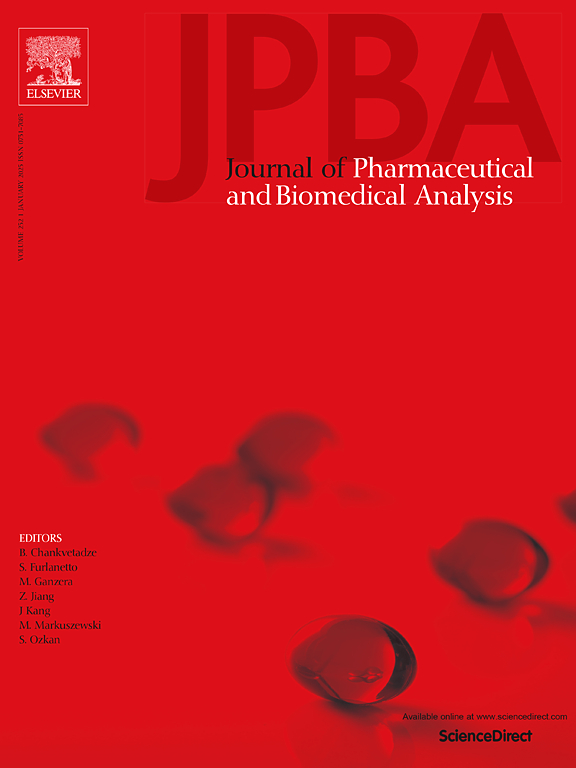利用分子网络辅助分析不同部位的 Ribes diacanthum pall 中的化学成分及其生物活性特性
IF 3.1
3区 医学
Q2 CHEMISTRY, ANALYTICAL
Journal of pharmaceutical and biomedical analysis
Pub Date : 2025-04-11
DOI:10.1016/j.jpba.2025.116901
引用次数: 0
摘要
Ribes diacanthum Pall(RDP)是一种药用和食用植物,因其多种多样的生物活性成分而广受认可,在蒙古民间医药中被广泛用于治疗各种疾病。从 RDP 的气生部分(包括果实、茎和叶)制备的煎剂和水乙醇提取物已被用于疾病治疗。然而,对果实、茎和叶的化学成分和生物活性特性的全面比较分析仍有待进行。为了弥补这一空白,我们对 RDP 果实、茎和叶的化学多样性和生物活性特性进行了详细调查。我们使用 HPLC-QTOF-MS/MS 分析了提取物的植物化学成分,并评估了其体外生物活性,包括抗氧化、细胞毒性、抗炎和保肝活性。共鉴定出 55 种化合物存在于 RDP 的不同部位,其中 28 种在果实中检测到,16 种在茎中检测到,33 种在叶片中检测到;值得注意的是,有 5 种化合物在所有植物部位中都存在。具体来说,RDP 果实具有独特的氨基酸(L-酪氨酸和 Abrine)以及独特的黄酮类化合物(Eriodictyol 和 Cyanidin-3-o-arabinose chloride)和苯丙类化合物(阿魏酸和咖啡酸甲酯)、而茎则含有独特的脂肪酸衍生物(9,10-二羟基-8-氧代十八-12-烯酸)、环状多酮(霉酚酸)和几种色氨酸生物碱(副酰胺 D)。相比之下,叶片中的黄酮类化合物(堪非醇-3-O-鼠李糖苷和堪非醇-7-O-新橙皮苷)、酚酸类化合物(没食子酸)和大环内酯类化合物(焦酚)的含量特别丰富。DPPH和ABTS自由基清除活性的IC50值依次为:DPPH,RDP叶(0.1047毫克/毫升);RDP茎(0.2173毫克/毫升);ABTS,RDP叶(0.2362毫克/毫升);RDP茎(0.5218毫克/毫升);RDP果(1.182毫克/毫升)。采用 LPS 或 TCA/CDCA 诱导的 AML-12 细胞模型来评估提取物的细胞毒性、抗炎作用及其潜在的保肝作用。结果表明,RDP 的不同部分对 LPS 诱导的 AML-12 细胞炎症有明显的抗炎作用,并能减轻 TCA 或 CDCA 诱导的肝毒性。值得注意的是,芦竹叶对三氯乙酸或三氯乙酸诱导的细胞毒性具有最有效的保护作用,其次是茎和果实。总之,这些发现为广泛应用从 RDP 果实、茎和叶中提取的植物化学物质和生物活性化合物提供了科学依据。本文章由计算机程序翻译,如有差异,请以英文原文为准。
Analysis of chemical constituents in different parts of Ribes diacanthum pall using molecular network assistance and their bioactive properties
Ribes diacanthum Pall (RDP) is a medicinal and edible plant recognized for its diverse bioactive constituents and has been widely utilized in Mongolian folk medicine for the treatment of various ailments. Decoctions and hydroethanolic extracts prepared from the aerial parts of RDP, including the fruits, stems, and leaves, have been employed in disease management. However, a comprehensive comparative analysis of the chemical profiles and bioactive properties of the fruits, stems, and leaves remains to be conducted. To bridge this gap, we conducted a detailed investigation into the chemical diversity and bioactive properties of the fruits, stems, and leaves of RDP. The phytochemical composition of the extracts was analyzed using HPLC-QTOF-MS/MS, and the in vitro bioactivities, including antioxidant, cytotoxic, anti-inflammatory, and hepatoprotective activities, were evaluated. A total of 55 compounds were identified across the various parts of RDP, with 28 detected in the fruits, 16 in the stems, and 33 in the leaves; notably, 5 compounds were common to all plant parts. Specifically, RDP fruits were characterized by unique amino acids (L-tyrosine and Abrine) as well as distinct flavonoids (Eriodictyol and Cyanidin-3-o-arabinose chloride) and phenylpropanoids (Ferulic acid and Caffeic acid methyl ester), whereas the stems contained unique fatty acid derivatives (9,10-Dihydroxy-8-oxooctadec-12-enoic acid), cyclic polyketides (Mycophenolic acid), and several tryptophan alkaloids (Paratunamide D). In contrast, the leaves were particularly rich in flavonoids (Kaempferol 3-O-rhamninoside and Kaempferol-7-O-neohesperidoside), phenolic acids (Gallic acid), and macrolides (Pyrenophorol). The DPPH and ABTS radical scavenging activities followed this order of IC50 values: for DPPH, RDP leaves (0.1047 mg/ml) > RDP stems (0.2173 mg/ml) > ; for ABTS, RDP leaves (0.2362 mg/ml) > RDP stems (0.5218 mg/ml) > RDP fruits (1.182 mg/ml). AML-12 cell models induced with LPS or TCA/CDCA were employed to evaluate the cytotoxicity and anti-inflammatory effect of the extracts and their potential hepatoprotective effects. The results indicated that the various parts of RDP exhibited significant anti-inflammatory effects against LPS-induced inflammation in AML-12 cells and alleviated TCA or CDCA-induced hepatotoxicity. Notably, RDP leaves demonstrated the most effective protective effect against TCA or CDCA-induced cytotoxicity, followed by the stems and fruits. In summary, these findings provide a scientific basis for the extensive application of phytochemicals and bioactive compounds derived from the fruits, stems, and leaves of RDP.
求助全文
通过发布文献求助,成功后即可免费获取论文全文。
去求助
来源期刊
CiteScore
6.70
自引率
5.90%
发文量
588
审稿时长
37 days
期刊介绍:
This journal is an international medium directed towards the needs of academic, clinical, government and industrial analysis by publishing original research reports and critical reviews on pharmaceutical and biomedical analysis. It covers the interdisciplinary aspects of analysis in the pharmaceutical, biomedical and clinical sciences, including developments in analytical methodology, instrumentation, computation and interpretation. Submissions on novel applications focusing on drug purity and stability studies, pharmacokinetics, therapeutic monitoring, metabolic profiling; drug-related aspects of analytical biochemistry and forensic toxicology; quality assurance in the pharmaceutical industry are also welcome.
Studies from areas of well established and poorly selective methods, such as UV-VIS spectrophotometry (including derivative and multi-wavelength measurements), basic electroanalytical (potentiometric, polarographic and voltammetric) methods, fluorimetry, flow-injection analysis, etc. are accepted for publication in exceptional cases only, if a unique and substantial advantage over presently known systems is demonstrated. The same applies to the assay of simple drug formulations by any kind of methods and the determination of drugs in biological samples based merely on spiked samples. Drug purity/stability studies should contain information on the structure elucidation of the impurities/degradants.

 求助内容:
求助内容: 应助结果提醒方式:
应助结果提醒方式:


